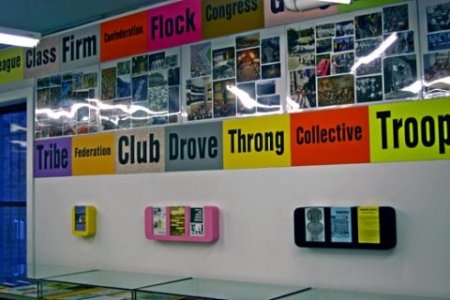
On the Functions of Documenta
Radical Culture Research Collective

On the Functions of Documenta
Radical Culture Research Collective

The Summer of Love show at the Whitney Museum is great fun. It’s full of experiences – walk-in and peer-in rooms and boxes, kinetic sculptures, video and film, album and underground newspaper covers, photos of celebs and jes folks, and even some painting and sculpture. Coming from the Tate Liverpool, the show’s strategy is to represent visual culture rather than high art. That’s cool. You can almost hear the music and taste the drugs…
 ...is how I thought of the chubbier part of the Biennale de Montreal that I saw in mid-May. (The show is suburbanized, and I'm on foot here.) It was a long weekend, being Victoria Day on Monday. Sigh. The city is deserted. It would look rather like Surrealist Paris if all those lovely statues in the square with their beaux arts nymphs and goddesses hadn't been spoiled by being topped by a stuffy looking man in a suit. It's like putting a turd on an ice cream Sunday. At least the seagulls are shitting on the King's head...
...is how I thought of the chubbier part of the Biennale de Montreal that I saw in mid-May. (The show is suburbanized, and I'm on foot here.) It was a long weekend, being Victoria Day on Monday. Sigh. The city is deserted. It would look rather like Surrealist Paris if all those lovely statues in the square with their beaux arts nymphs and goddesses hadn't been spoiled by being topped by a stuffy looking man in a suit. It's like putting a turd on an ice cream Sunday. At least the seagulls are shitting on the King's head...

I arrive at the Zwirner Gallery’s double show of Rirkrit Tiravanija and Gordon Matta-Clark, rolling my bicycle up to the front of the kitchen and locking it before the window-like openings. I enter the dumpster with the maze built inside it. With its back panel open, the dumpster is the major opening of the double installation to the street.

Temporary Services was in town at the end of March. They are a Chicago group which perform “services.” (Service as art, or as a social good which artists produce, was described and debated by Andrea Fraser and friends in a mid-1990s conference in Europe). Temporary Services make many ‘zines, little booklets and brochures on various topics, in accelerating profusion. Their many recent shows around the world have been basically about “servicing,” and then making a ‘zine and pushing it out. Now they have svelte, lozenge-shaped ‘zine dispensers to give these things away – forms that recall Artschwager crossed with Gonzalez-Torres. That’s artistic form both material and social…

I attended this year’s College Art Association conference in New York last week. In a room mobbed with hundreds of women, an exciting panel took place as part of the Feminist Art program. It was organized by Suzanne Lacy with her guests Martha Rosler and Nato Thompson. (Lacy is the social sculptor who wrote about “new genre public art” ten years ago; Rosler is an internationally famous political artist; Thompson is the curator who organized the Interventionist show at Mass MOCA, and is soon to move to Creative Time in NYC.) Here are my raw notes with interpolations in brackets.
![]()
Scott Rigby of Basekamp talked me into coming to Philadelphia for the ICA show “Locally Localized Gravity” (through March 25, 2007). He asked me to talk about histories of collective art. I arrived late on one of the museum’s “Whenever Wednesdays,” and ran into the place, noting only the large blur of a multi-colored structure reminiscent of the Ewok village from Star Wars on one side of the large main gallery, and scattered groups of people. One bunch seemed to be dancing, dozens of folks standing on a big black-painted raised stage. Another group was squatted in a circle inside a tent on pillows talking.
Interfunktionen and Avalanche at the Modern
After the sardine lecture at Storefront (see last post), there was more chat about the legendary little magazines of the 1970s. December 10th the Museum of Modern Art convened called “Experimental Magazines and the International Avant-Gardes, 1945–1975." The panel discussion, said moderator David Little, coincides with the “Eye on Europe” show and the “American Fantastica” exhibition. So it may have. But the weight of the panel was ‘70s. Edward Sullivan seemed misplaced speaking generally about the landscape of Latin American modernist journals, so I am going to ignore his remarks. The stars of the panel for me were Benjamin Buchloh speaking on the avant garde German publication Interfunktionen, and Willoughby Sharp and Liza Bear, co-editors of Avalanche, the NYC magazine of new art published in the early 1970s.
I am stuffed into the Storefront for Art and Architecture on December 9th with a subway car-load of smart, good-looking white people listening to three gods of October talking at the “Clip/Stamp/Fold Radical Architecture of Little Magazines 196X-197X” exhibition. Actually, as the exhibition, curated by Beatriz Colomina and a team from Princeton (see clipstampfold.com). It’s Rosalind Krauss, Yve-Alain Bois and Hal Foster.